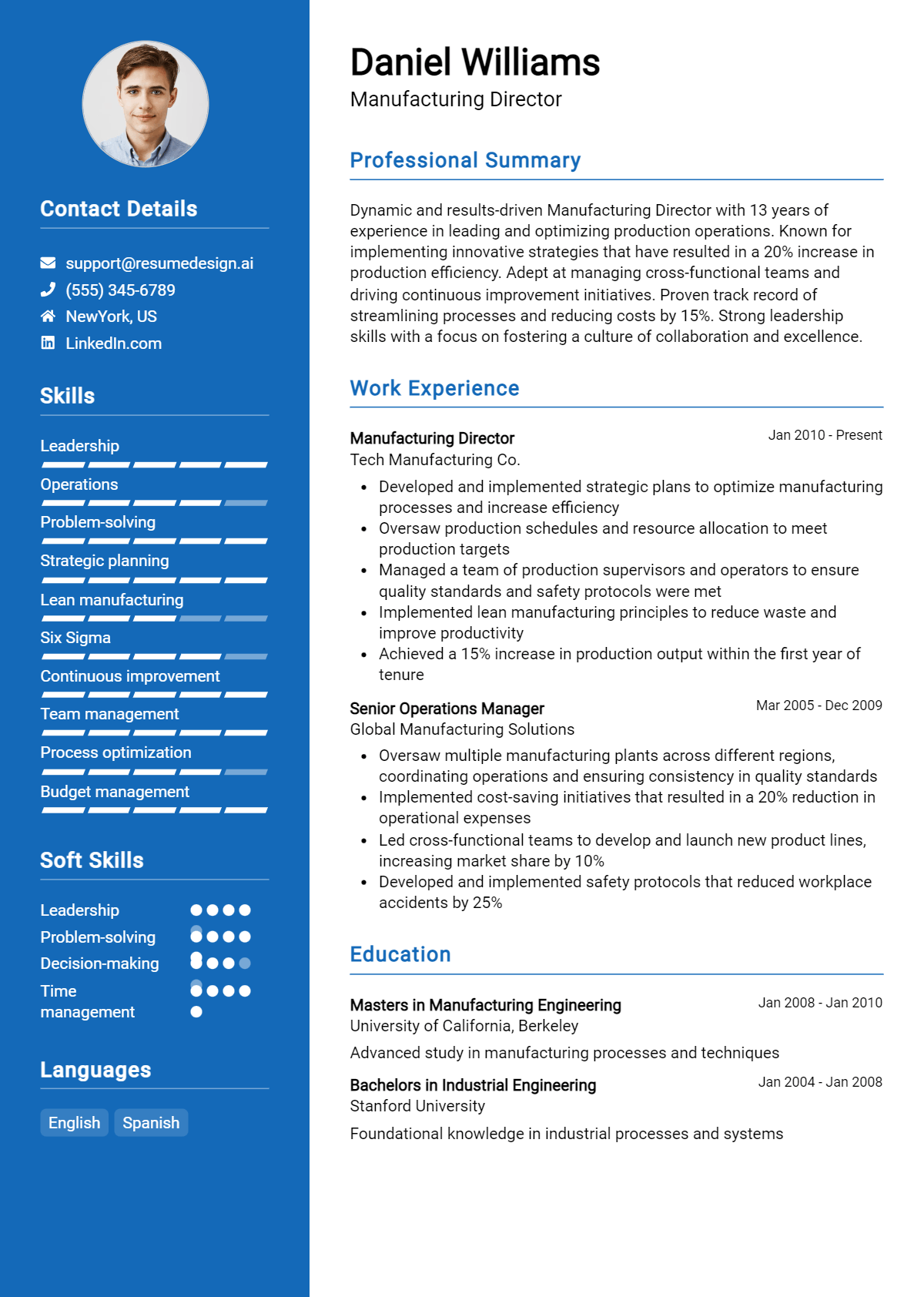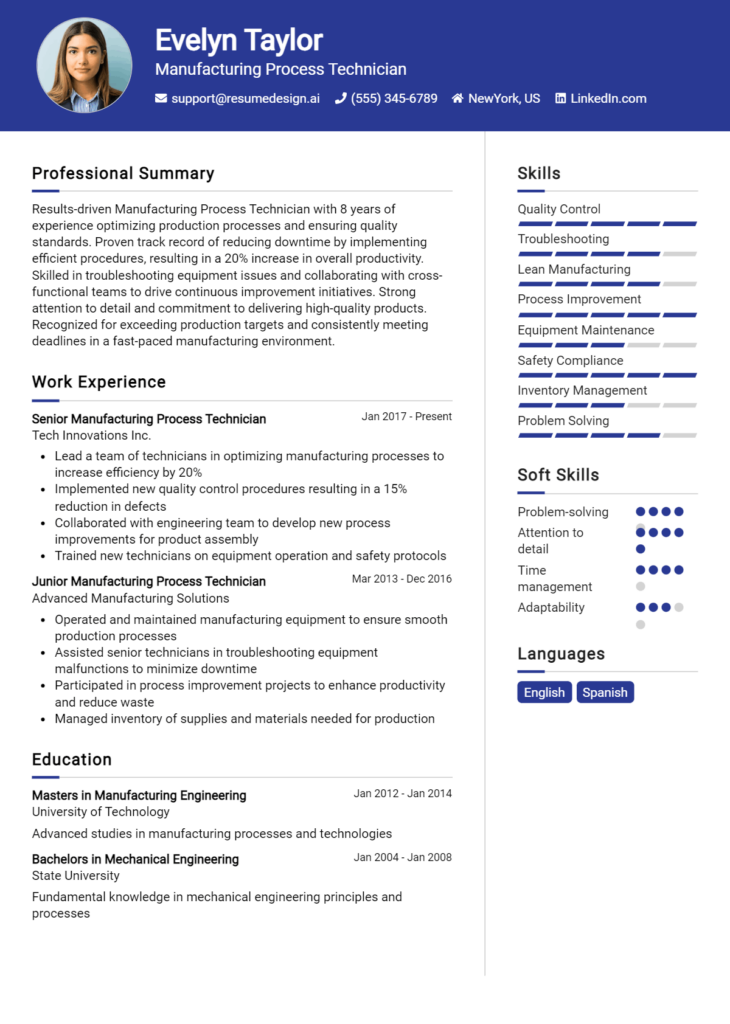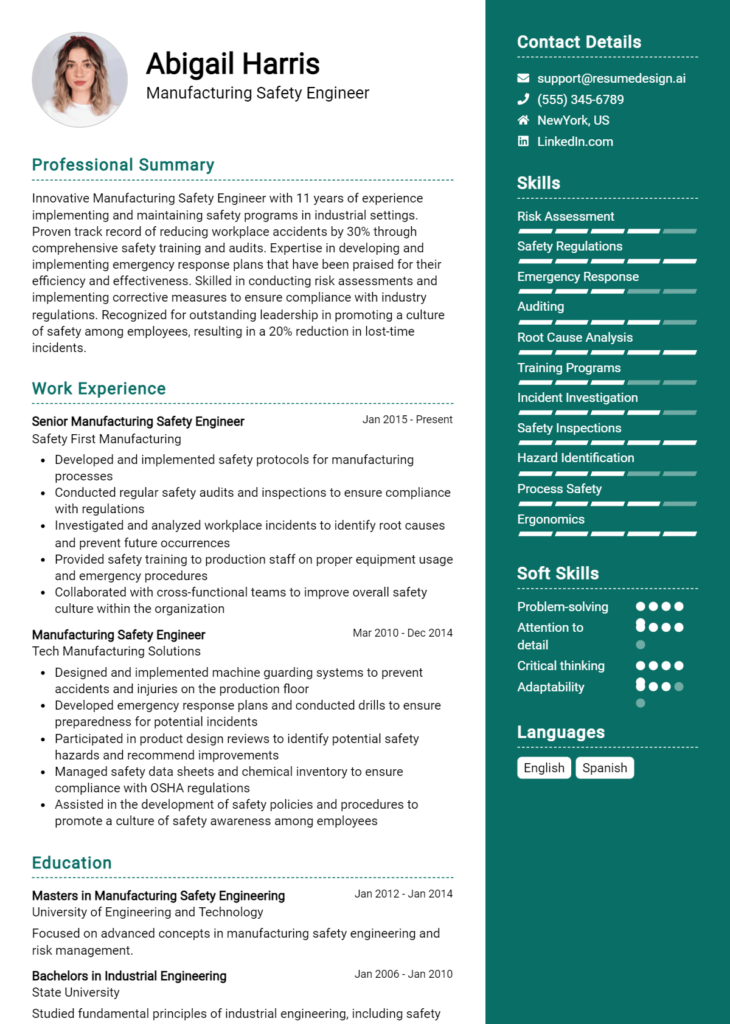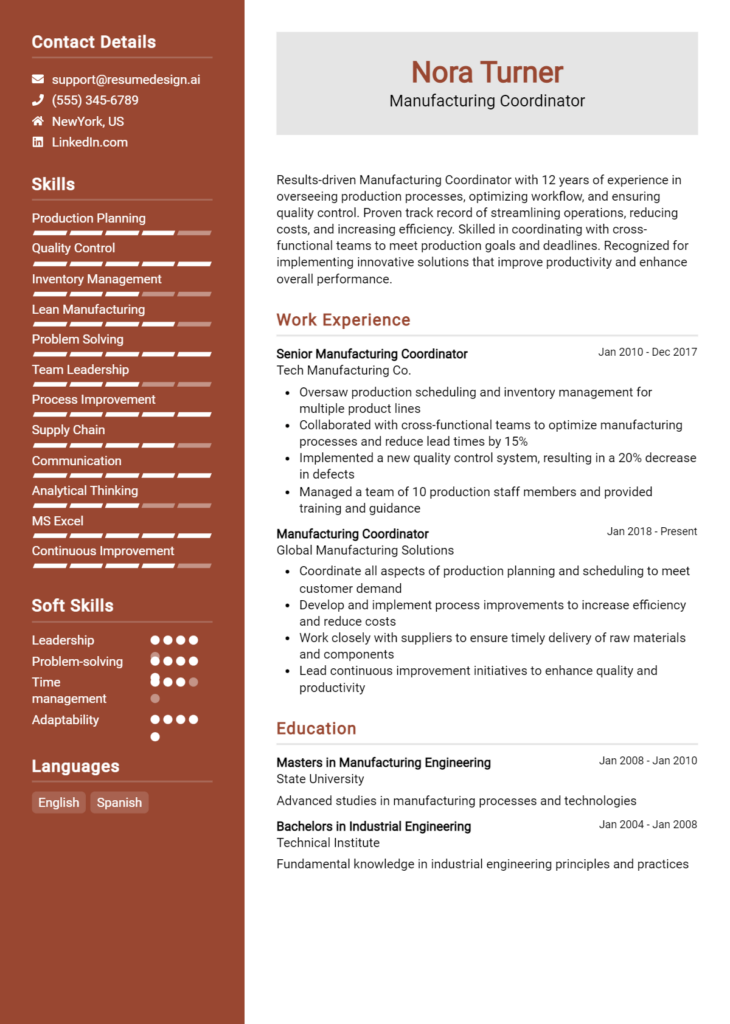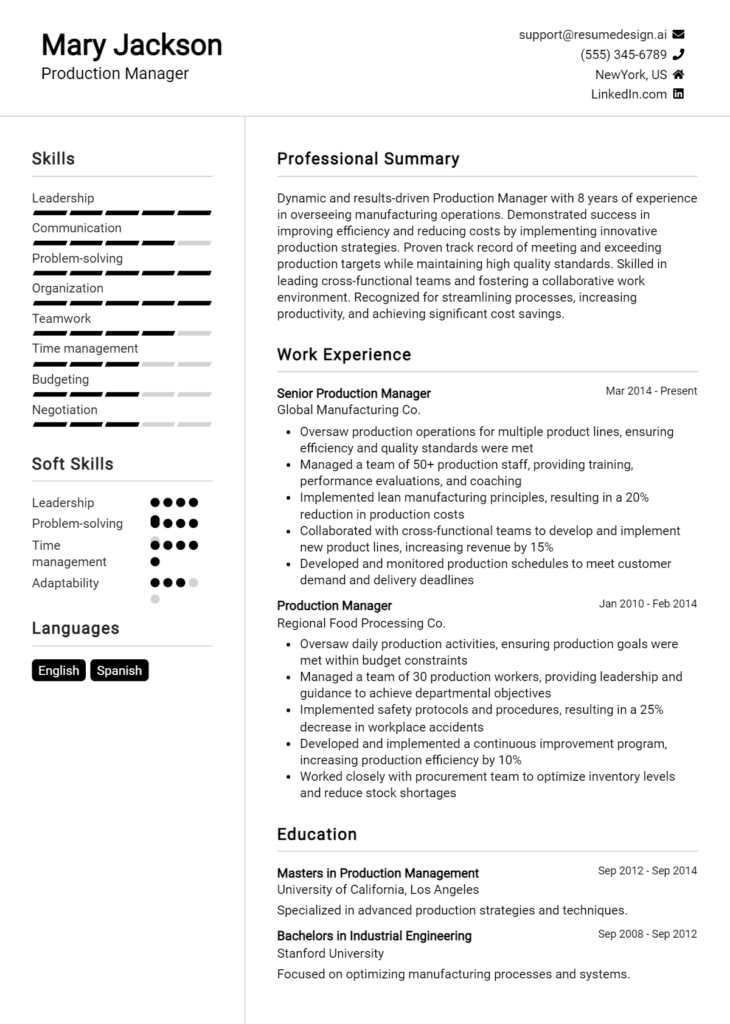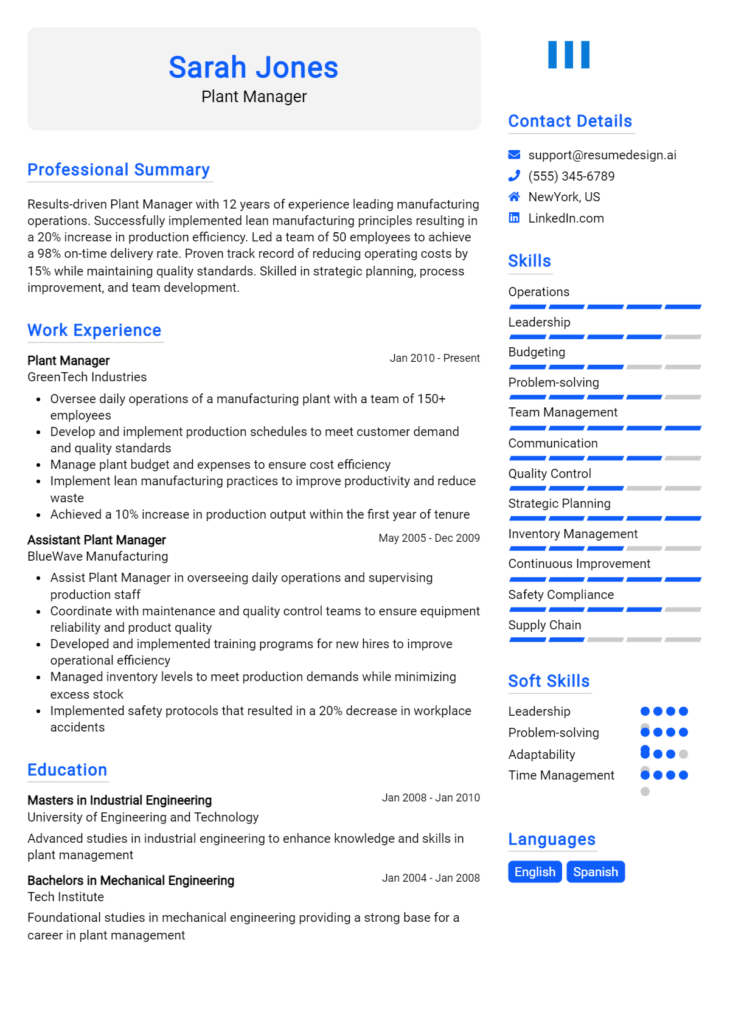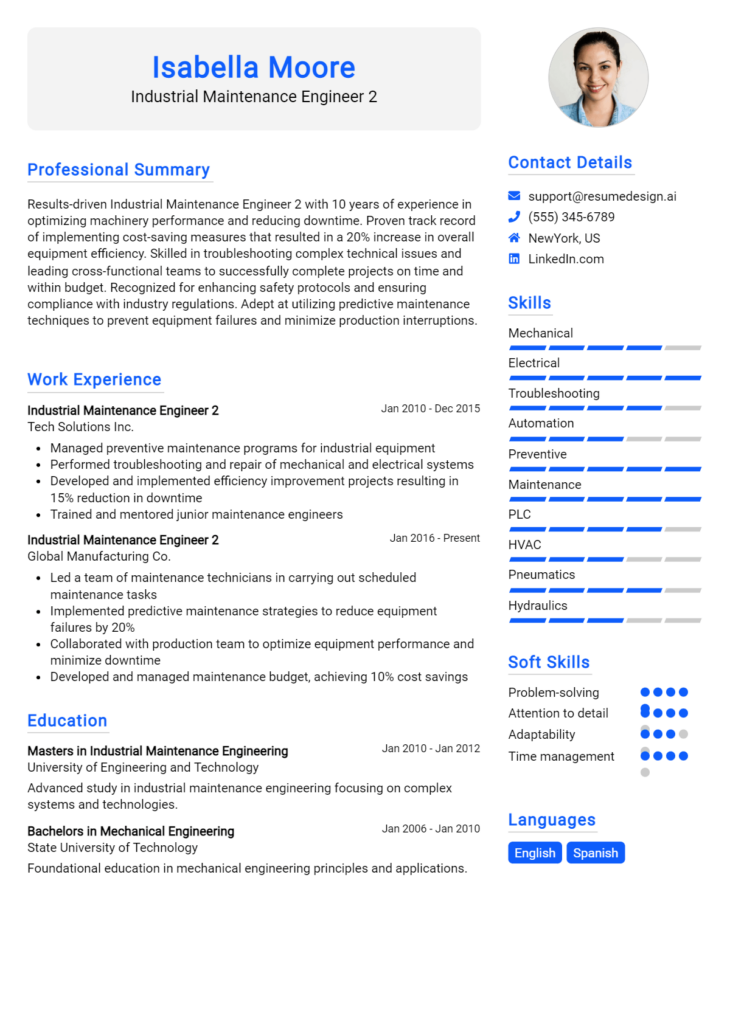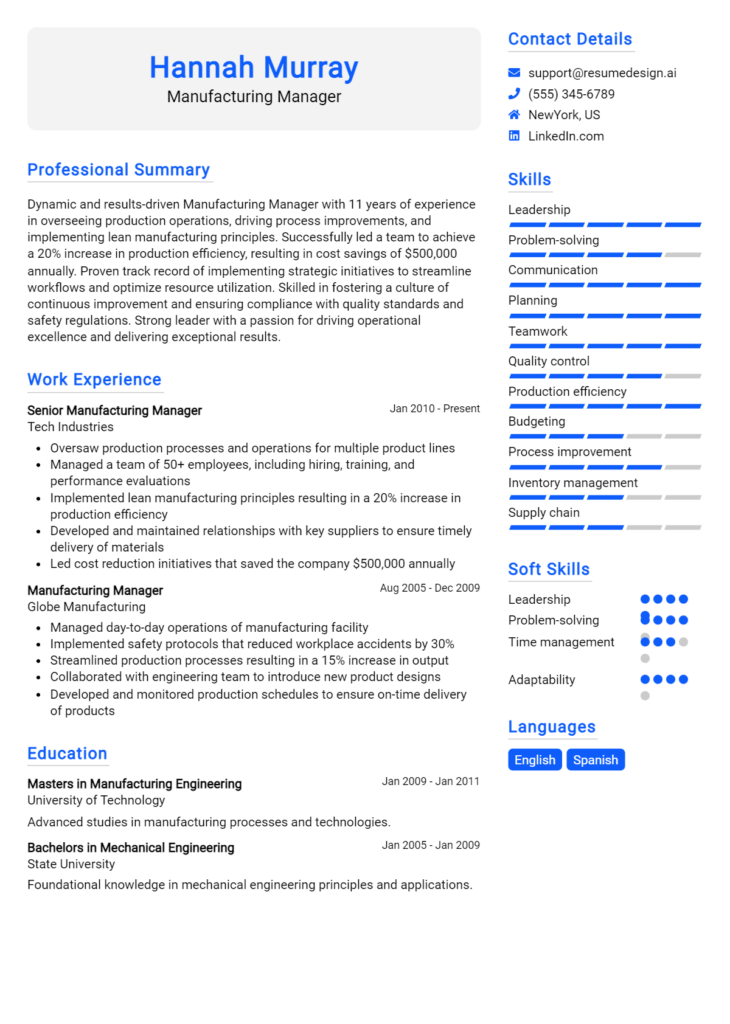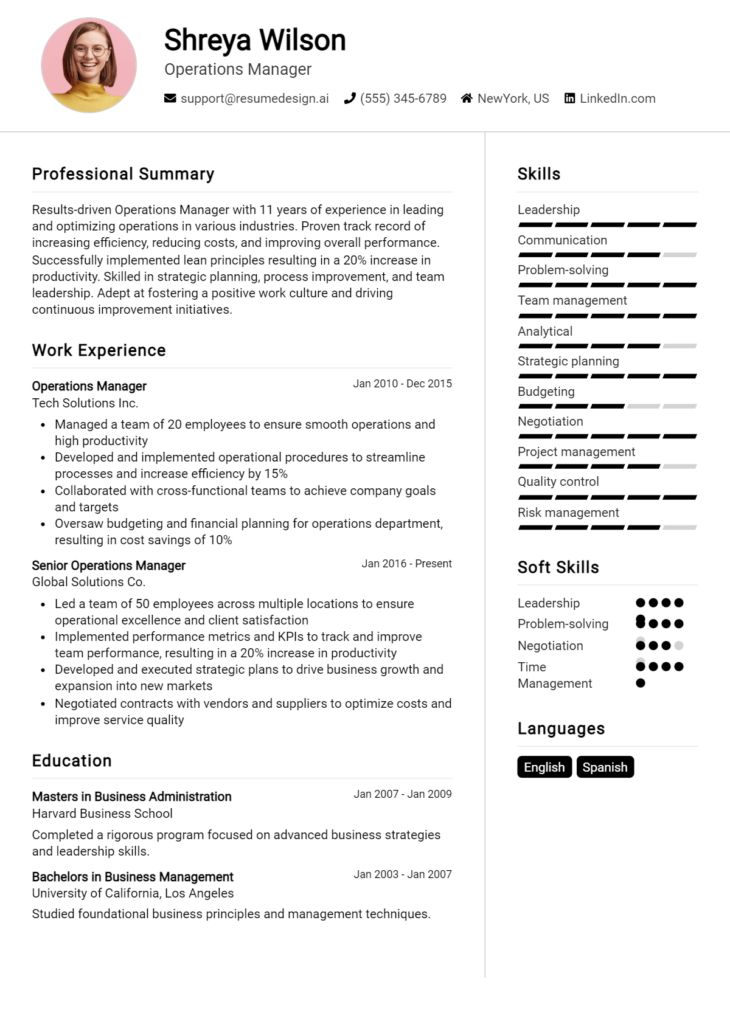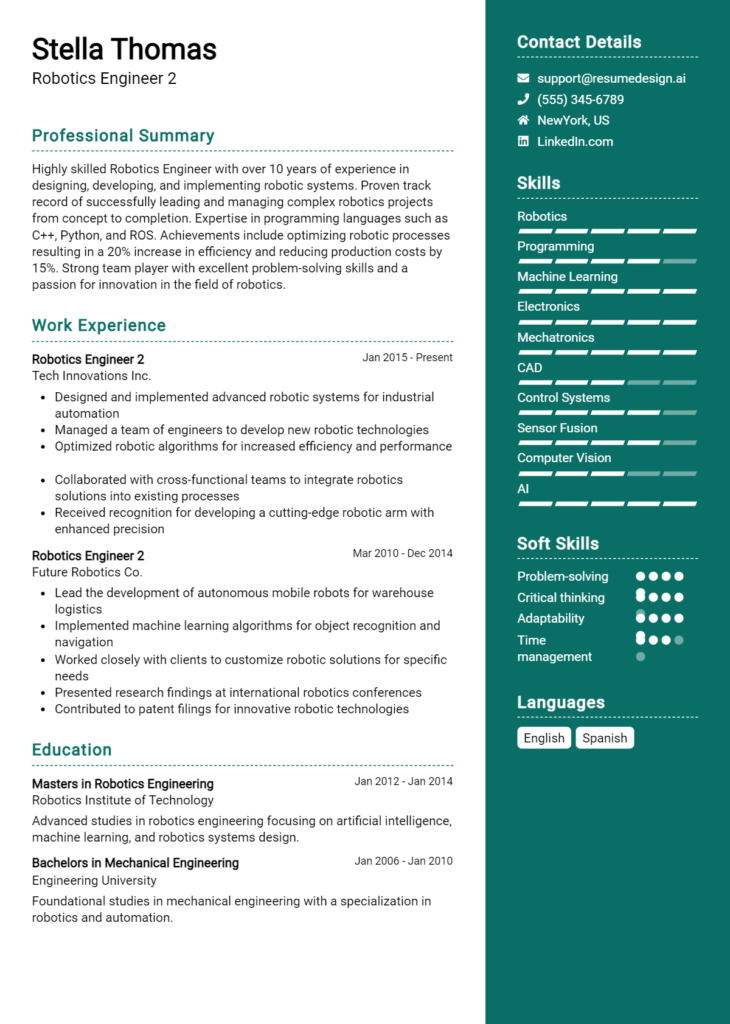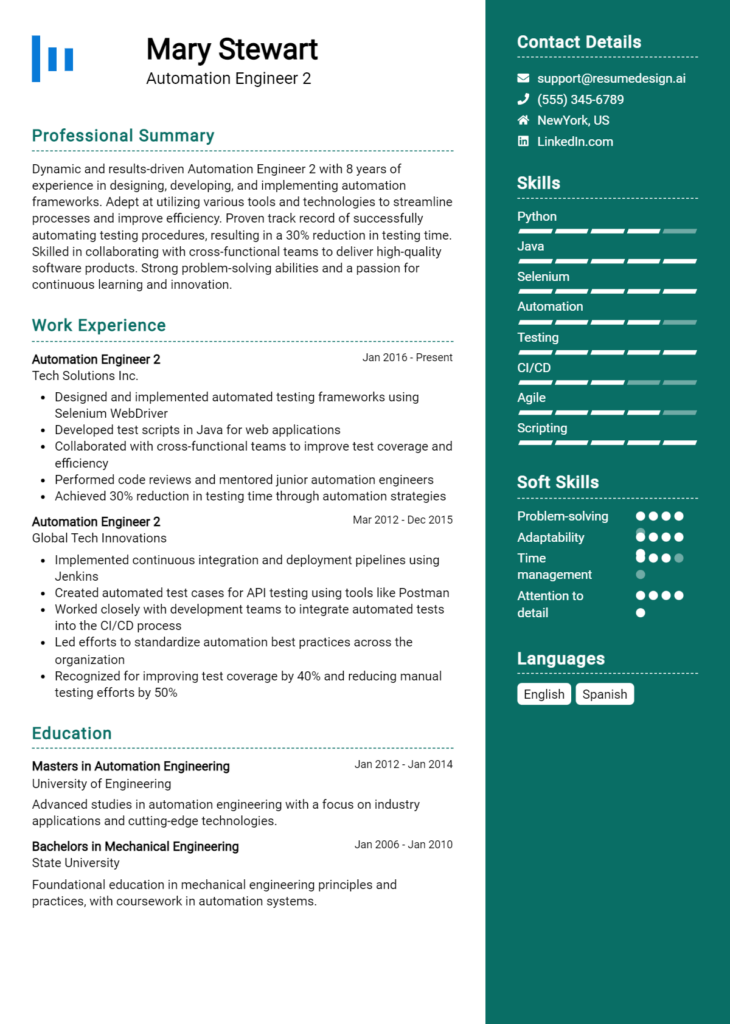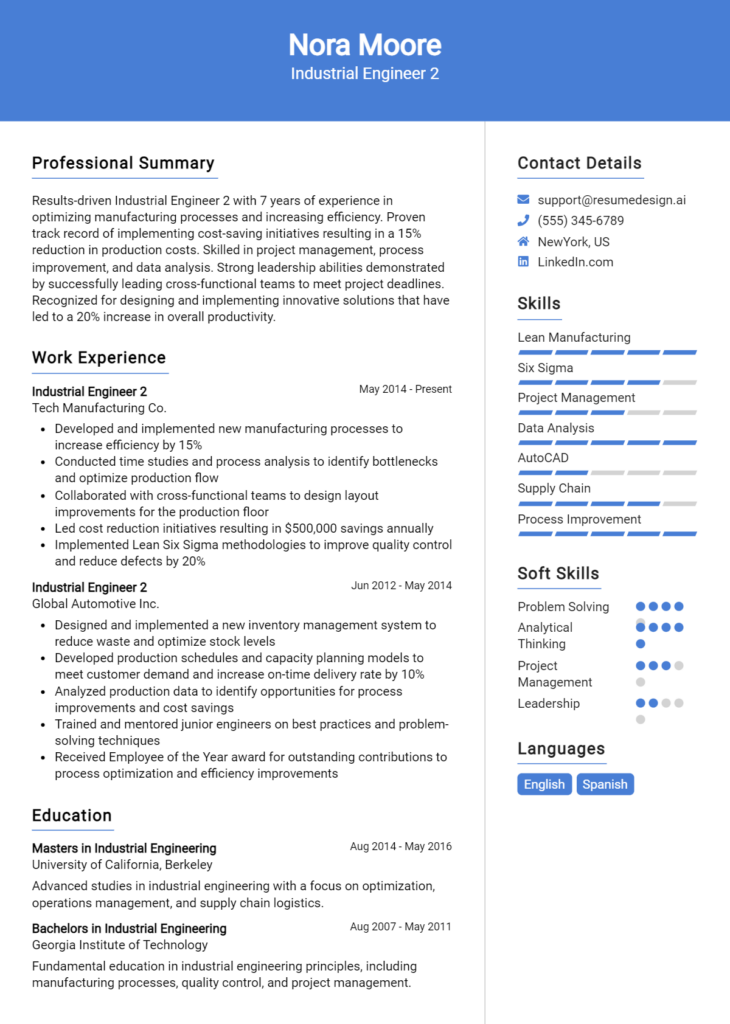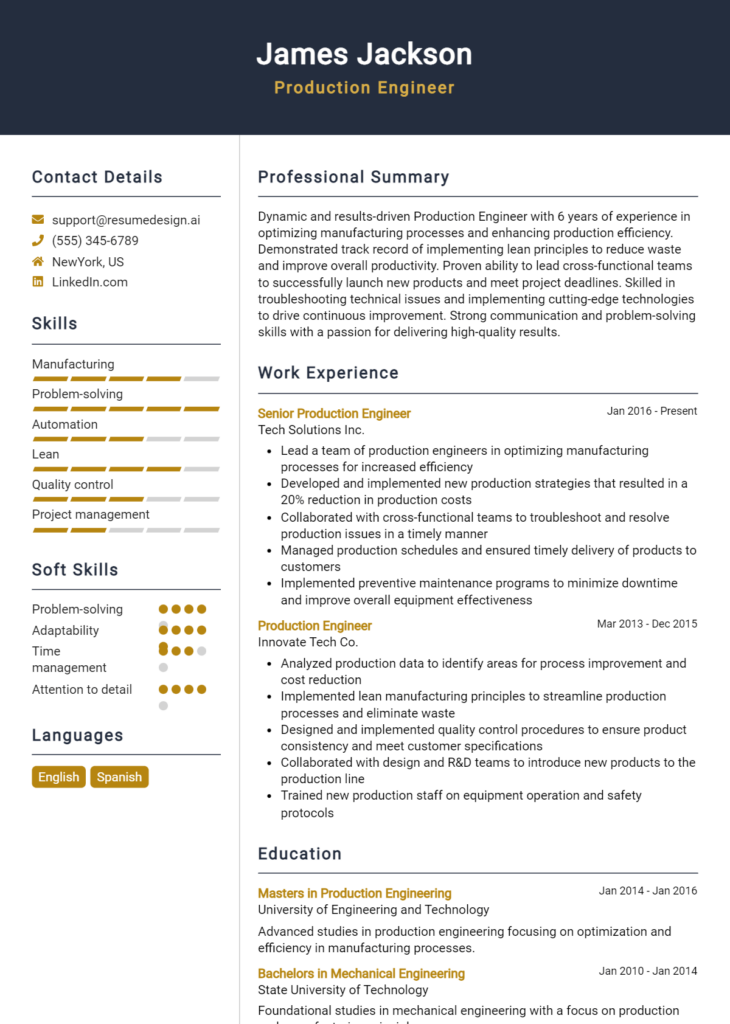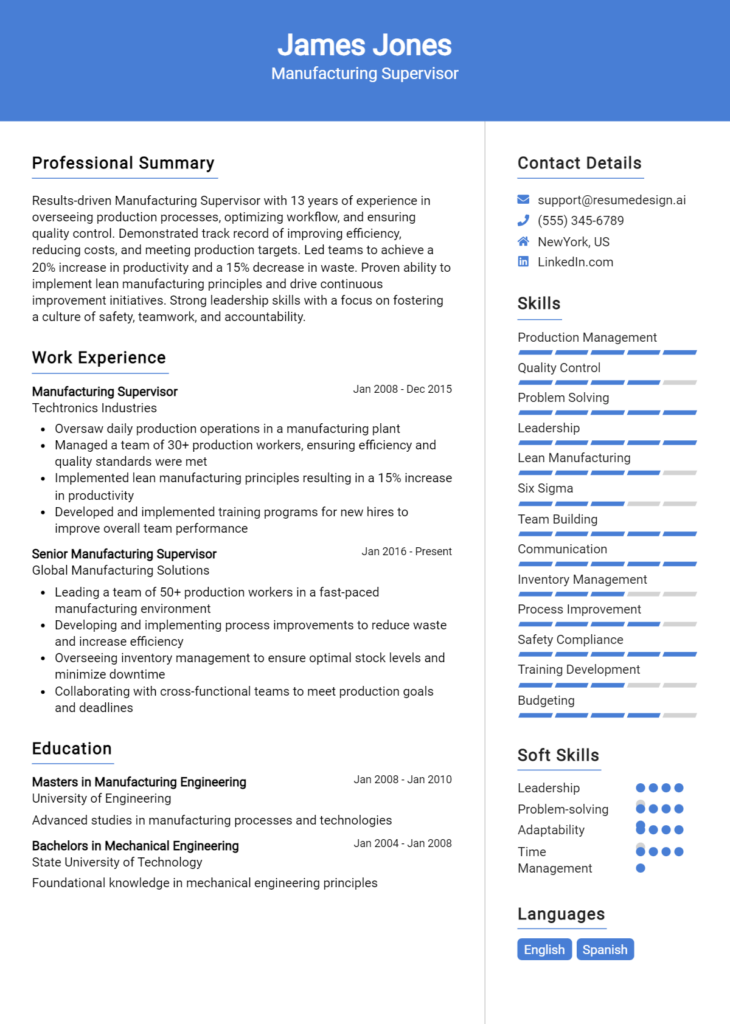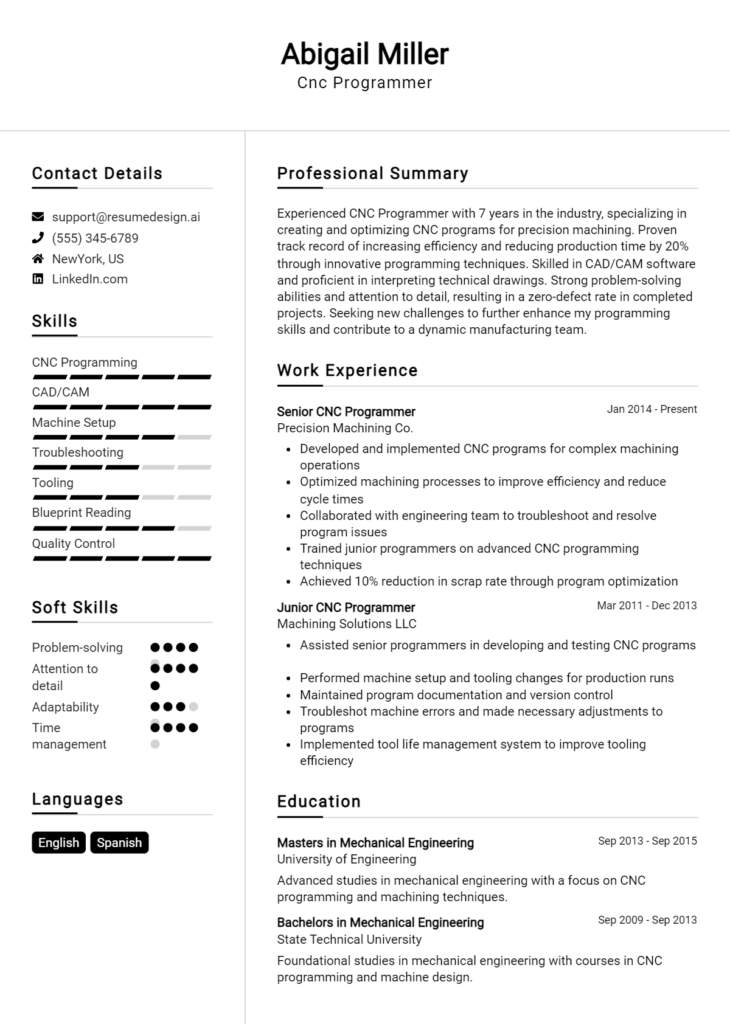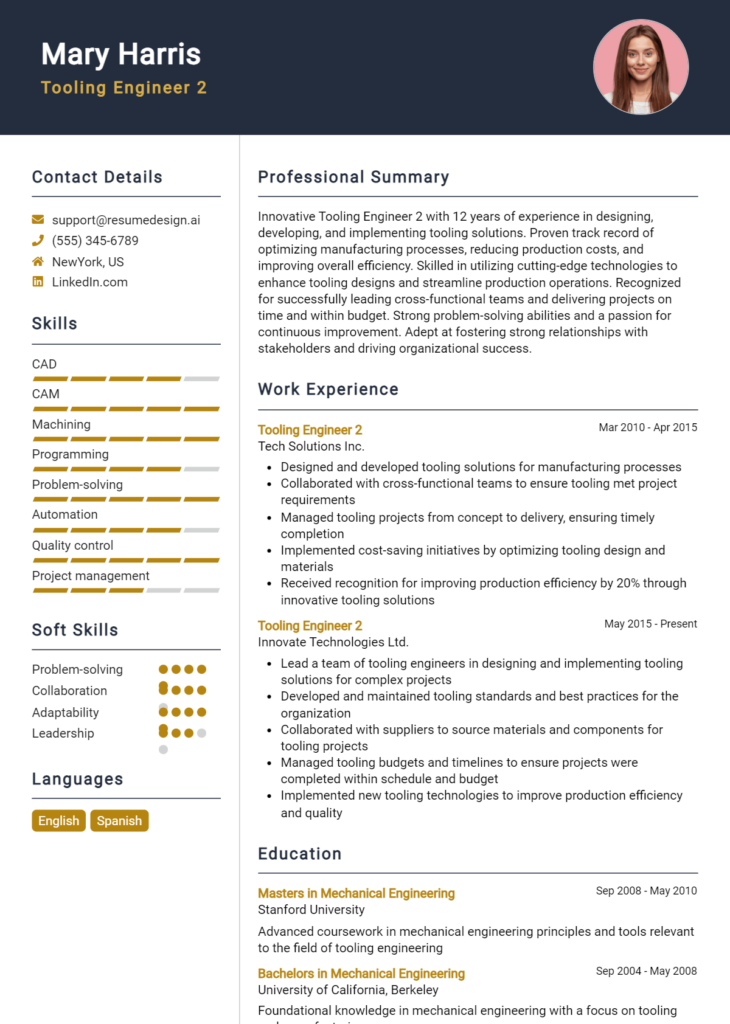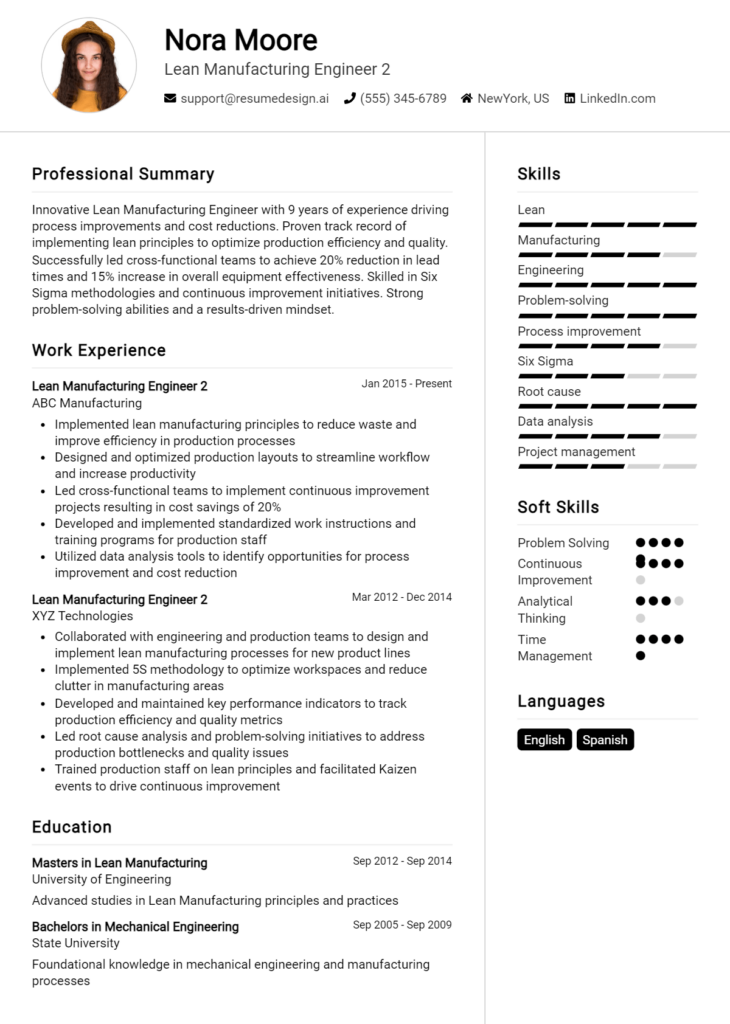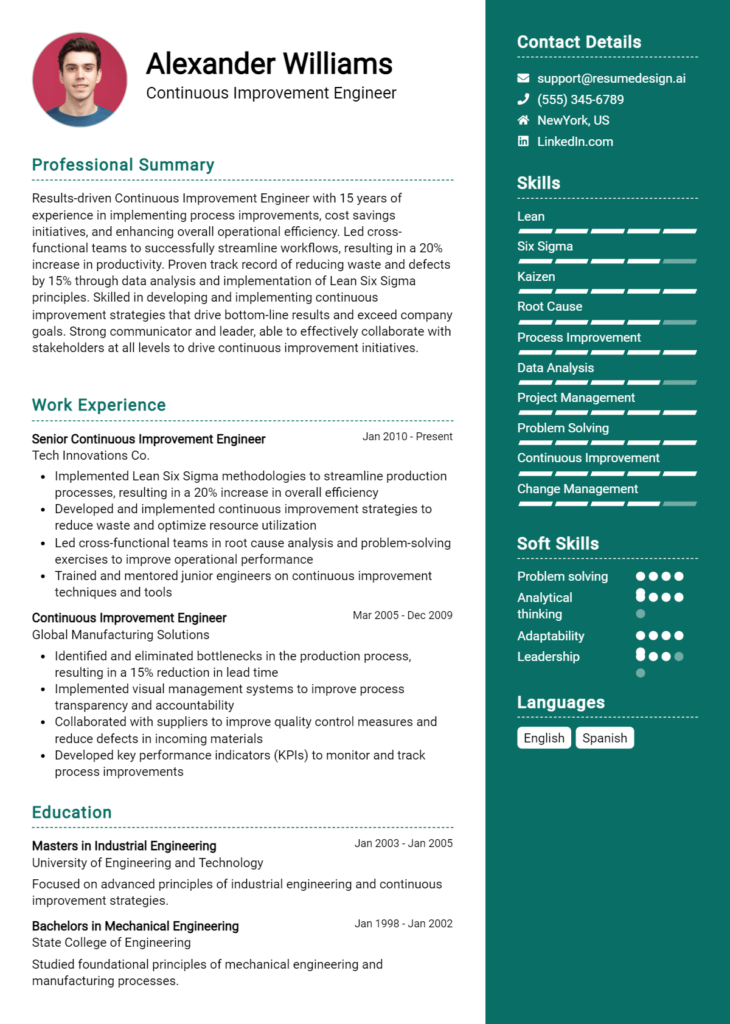Manufacturing Director Core Responsibilities
The Manufacturing Director plays a critical role in overseeing production processes and ensuring operational efficiency across various departments. Key responsibilities include strategic planning, resource allocation, and quality assurance, requiring strong technical, operational, and problem-solving skills. This role serves as a vital link between engineering, production, and supply chain teams, driving collaboration to meet organizational goals. A well-structured resume can effectively highlight these competencies, showcasing a candidate's capability to lead and innovate within the manufacturing sector.
Common Responsibilities Listed on Manufacturing Director Resume
- Develop and implement manufacturing strategies to enhance productivity.
- Oversee production operations to ensure compliance with safety and quality standards.
- Manage cross-functional teams to optimize workflow and efficiency.
- Analyze production data to identify areas for improvement.
- Coordinate with supply chain management to ensure timely delivery of materials.
- Lead continuous improvement initiatives and lean manufacturing practices.
- Establish and monitor key performance indicators (KPIs) for production teams.
- Develop and manage budgets for manufacturing operations.
- Foster a culture of safety, quality, and accountability within the workforce.
- Collaborate with R&D to integrate new technologies into manufacturing processes.
- Conduct regular training and development programs for staff.
- Prepare reports for upper management regarding production performance and challenges.
High-Level Resume Tips for Manufacturing Director Professionals
In today's competitive job market, a well-crafted resume is absolutely essential for Manufacturing Director professionals. This document serves as your first impression to potential employers, making it crucial that it effectively showcases not only your skills but also your significant achievements in the manufacturing sector. A compelling resume can set you apart from the competition and open doors to new opportunities. This guide will provide you with practical and actionable resume tips specifically tailored for Manufacturing Director professionals, ensuring that your application makes a lasting impact.
Top Resume Tips for Manufacturing Director Professionals
- Tailor your resume to the job description by incorporating relevant keywords and phrases that align with the specific requirements of the position.
- Highlight your leadership experience, emphasizing your ability to manage teams, drive performance, and foster a culture of safety and efficiency.
- Quantify your achievements with specific metrics, such as percentage improvements in production efficiency, cost reductions, or increases in output.
- Showcase your expertise in industry-specific tools and technologies, such as Lean Manufacturing, Six Sigma, or ERP systems.
- Include a summary statement at the top of your resume that succinctly encapsulates your career highlights and goals.
- Demonstrate your strategic planning skills by outlining successful initiatives you've led that contributed to organizational growth.
- Incorporate relevant certifications and professional development experiences that enhance your qualifications, such as PMP or Lean certifications.
- Emphasize your ability to build and maintain relationships with suppliers, stakeholders, and clients to demonstrate your collaborative approach.
- Utilize bullet points for clarity and conciseness, making it easy for hiring managers to quickly identify your strengths.
- Proofread meticulously to avoid any errors, as attention to detail is crucial in a leadership role within manufacturing.
By implementing these resume tips, you can significantly enhance your chances of landing a job in the Manufacturing Director field. A polished and targeted resume will not only reflect your qualifications but also demonstrate your commitment to excellence, making you a strong contender for leadership positions in the industry.
Why Resume Headlines & Titles are Important for Manufacturing Director
In the competitive landscape of manufacturing, the role of a Manufacturing Director is pivotal, overseeing operations, optimizing processes, and driving innovation. A strong resume headline or title is essential as it serves as the first impression for hiring managers. It succinctly captures the essence of a candidate's qualifications and experiences, making it easier for recruiters to quickly assess suitability for the role. A well-crafted headline should be concise, relevant, and directly aligned with the job being applied for, ensuring it resonates with the specific demands of the manufacturing sector.
Best Practices for Crafting Resume Headlines for Manufacturing Director
- Keep it concise: Aim for a headline that is no more than 10-12 words.
- Be specific: Use keywords that directly relate to the Manufacturing Director role.
- Highlight key strengths: Focus on your most relevant skills and achievements.
- Use action-oriented language: Start with verbs that convey leadership and impact.
- Tailor for each application: Customize your headline for the specific job description.
- Include measurable outcomes: If possible, reference quantifiable achievements.
- Avoid jargon: Use clear and straightforward language that all readers will understand.
- Showcase industry knowledge: Incorporate terms or qualifications specific to the manufacturing sector.
Example Resume Headlines for Manufacturing Director
Strong Resume Headlines
Dynamic Manufacturing Director with 15+ Years in Lean Operations and Cost Reduction
Results-Driven Leader Specializing in Automation and Workforce Optimization
Strategic Manufacturing Executive with Proven Track Record of Enhancing Production Efficiency
Innovative Manufacturing Director Focused on Sustainable Practices and Quality Improvement
Weak Resume Headlines
Experienced Professional Seeking Manufacturing Role
Manufacturing Director with Many Skills
Looking for a Job in Manufacturing Management
The strong headlines are effective because they immediately convey specific expertise and demonstrate a clear understanding of the Manufacturing Director role. They highlight relevant skills and accomplishments, making a compelling case for the candidate's fit for the position. In contrast, the weak headlines fail to impress due to their vagueness and lack of detail; they do not provide any insight into the candidate's qualifications or the value they could bring to the organization, leaving hiring managers uninspired and unengaged.
Writing an Exceptional Manufacturing Director Resume Summary
A well-crafted resume summary is crucial for a Manufacturing Director, as it serves as the first impression a candidate makes on potential employers. A strong summary quickly captures the attention of hiring managers by succinctly showcasing key skills, relevant experience, and notable accomplishments that align with the job role. It should be concise, impactful, and specifically tailored to the job the candidate is applying for, effectively setting the tone for the rest of the resume and demonstrating the candidate's suitability for the position.
Best Practices for Writing a Manufacturing Director Resume Summary
- Quantify Achievements: Use numbers and metrics to highlight your impact, such as production increases or cost reductions.
- Focus on Skills: Emphasize specific skills relevant to manufacturing, such as lean manufacturing, quality control, and team leadership.
- Tailor the Summary: Customize your summary to match the job description and the specific requirements of the employer.
- Highlight Leadership Experience: Showcase your experience in leading teams and managing projects effectively.
- Showcase Industry Knowledge: Include relevant industry terms and knowledge to demonstrate expertise in the manufacturing sector.
- Keep it Concise: Aim for 3-5 sentences that deliver maximum impact without overwhelming the reader.
- Use Action Verbs: Start sentences with strong action verbs to convey confidence and decisiveness.
- Maintain a Professional Tone: Ensure the language is formal yet approachable, reflecting your professionalism in the field.
Example Manufacturing Director Resume Summaries
Strong Resume Summaries
Dynamic Manufacturing Director with over 15 years of experience leading large-scale production operations. Achieved a 30% reduction in costs through lean manufacturing initiatives while increasing overall production output by 25%. Proven track record of enhancing team performance and driving continuous improvement in quality assurance processes.
Results-driven Manufacturing Director with a focus on supply chain optimization and operational efficiency. Led a team of 200+ staff, implementing automated systems that boosted productivity by 40% and decreased lead times by 15%. Recognized for excellence in quality management, achieving ISO 9001 certification for multiple facilities.
Strategic Manufacturing Director with expertise in developing cost-effective production solutions. Spearheaded a project that reduced material waste by 20% and improved product quality ratings by 35%. Strong leadership skills with a commitment to fostering a culture of safety and innovation.
Weak Resume Summaries
Experienced manufacturing professional looking for a new opportunity. Skilled in various manufacturing processes and team management.
Manufacturing Director with knowledge in production and quality control. Seeking to leverage my skills in a challenging environment.
The examples provided illustrate the distinction between strong and weak resume summaries. Strong summaries are characterized by specific achievements, quantifiable results, and relevant skills that directly align with the Manufacturing Director role. They effectively convey the candidate's value proposition to potential employers. In contrast, weak summaries lack detail, specificity, and measurable outcomes, making them less compelling and memorable to hiring managers.
Work Experience Section for Manufacturing Director Resume
The work experience section of a Manufacturing Director resume is critical as it serves as a testament to the candidate’s technical expertise, leadership capabilities, and history of delivering high-quality products. This section not only details previous roles but also highlights the specific skills and accomplishments that set the candidate apart. By quantifying achievements and aligning experiences with industry standards, applicants can effectively convey their impact on organizational success, streamline production processes, and foster a culture of continuous improvement.
Best Practices for Manufacturing Director Work Experience
- Emphasize technical skills relevant to manufacturing processes and technologies.
- Quantify achievements with metrics (e.g., percentage improvements, cost savings).
- Highlight leadership roles and team management experiences.
- Showcase collaboration across departments to achieve business objectives.
- Align work experience descriptions with current industry trends and standards.
- Use action verbs to convey a sense of initiative and impact.
- Include details about specific projects or initiatives that led to significant outcomes.
- Tailor your experience to the job description, ensuring relevance to potential employers.
Example Work Experiences for Manufacturing Director
Strong Experiences
- Led a cross-functional team that reduced production downtime by 30%, resulting in an annual savings of $500,000.
- Implemented lean manufacturing techniques that increased operational efficiency by 25%, improving overall product delivery timelines.
- Managed the successful rollout of a new quality control system that decreased defect rates by 15%, enhancing customer satisfaction scores.
- Collaborated with R&D to develop a new product line that generated $2 million in revenue within the first year of launch.
Weak Experiences
- Oversaw production operations and handled team issues.
- Worked on improving processes but did not track results.
- Took part in meetings to discuss production, but no significant changes were made.
- Responsible for ensuring product quality without specific examples of success.
The examples categorized as strong experiences are distinguished by their quantifiable outcomes, clear demonstration of technical leadership, and effective collaboration that led to substantial improvements in the manufacturing process. They provide concrete evidence of the candidate's abilities and achievements. In contrast, the weak experiences lack specificity and measurable results, failing to convey a sense of impact or effectiveness in the roles undertaken. This highlights the importance of presenting clear and compelling work experiences in a Manufacturing Director resume.
Education and Certifications Section for Manufacturing Director Resume
The education and certifications section of a Manufacturing Director resume is crucial as it provides a comprehensive overview of the candidate's academic background and professional development. This section not only showcases the foundational knowledge acquired through formal education but also highlights relevant industry certifications that demonstrate specialized skills and expertise. Including relevant coursework and any specialized training reflects a commitment to continuous learning, which is essential in the ever-evolving manufacturing landscape. By presenting a well-rounded education and certification profile, candidates can significantly enhance their credibility and alignment with the job role, making them more appealing to potential employers.
Best Practices for Manufacturing Director Education and Certifications
- Focus on relevant degrees such as Engineering, Business Administration, or Manufacturing Management.
- Include industry-recognized certifications like Lean Six Sigma, Certified Manufacturing Engineer (CMfgE), or Project Management Professional (PMP).
- Highlight any specialized training that pertains to advanced manufacturing technologies or methodologies.
- Provide details on coursework that aligns with key manufacturing processes, quality control, and supply chain management.
- List certifications in order of relevance and recency to showcase ongoing professional development.
- Avoid including degrees or certifications that are outdated or unrelated to the manufacturing sector.
- Consider incorporating memberships in relevant professional organizations to further validate expertise.
- Tailor the education and certifications section to align with the specific job description and required qualifications.
Example Education and Certifications for Manufacturing Director
Strong Examples
- M.S. in Manufacturing Engineering, University of Michigan, 2018
- Lean Six Sigma Black Belt Certification, ASQ, 2020
- B.S. in Industrial Engineering, Georgia Institute of Technology, 2015
- Certified Production and Inventory Management (CPIM), APICS, 2019
Weak Examples
- B.A. in History, State University, 2010
- Certification in Basic Computer Skills, Local Community College, 2012
- High School Diploma, Anytown High School, 2005
- Outdated certification in Quality Control Methods, 2010
The examples provided illustrate the distinction between strong and weak educational qualifications and certifications. Strong examples show relevant degrees and industry-recognized certifications that are directly applicable to the Manufacturing Director role, demonstrating both advanced knowledge and practical skills in the field. Conversely, weak examples include degrees and certifications that do not relate to manufacturing, indicating a lack of relevant expertise and diminishing the candidate's qualifications for the position.
Top Skills & Keywords for Manufacturing Director Resume
In the competitive landscape of manufacturing, the role of a Manufacturing Director is pivotal in steering production operations towards efficiency and excellence. A well-crafted resume is essential to showcase the specific skills that demonstrate a candidate's capability to lead teams, optimize processes, and drive innovation. Highlighting both hard and soft skills is crucial, as they collectively paint a comprehensive picture of a candidate's qualifications. By aligning these skills with the demands of the industry, a Manufacturing Director can effectively communicate their value to potential employers. For more insights on how to enhance your resume, consider exploring our resources on skills and work experience.
Top Hard & Soft Skills for Manufacturing Director
Soft Skills
- Leadership
- Communication
- Problem-solving
- Team collaboration
- Strategic thinking
- Adaptability
- Conflict resolution
- Time management
- Decision-making
- Negotiation skills
- Emotional intelligence
- Mentoring and coaching
- Customer focus
- Change management
- Critical thinking
- Creativity
Hard Skills
- Lean manufacturing techniques
- Six Sigma methodologies
- Project management
- Supply chain management
- Quality assurance and control
- Budgeting and financial analysis
- Safety compliance regulations
- Production planning and scheduling
- ERP software proficiency
- Data analysis and reporting
- Automation and robotics
- Process improvement strategies
- Inventory management
- Regulatory compliance
- Technical proficiency in manufacturing equipment
- Vendor management
- Capacity planning
Stand Out with a Winning Manufacturing Director Cover Letter
Dear [Hiring Manager's Name],
I am writing to express my interest in the Manufacturing Director position at [Company Name], as advertised on [where you found the job posting]. With over [number] years of experience in the manufacturing sector, I have honed my skills in operational excellence, strategic planning, and team leadership. My background in optimizing production processes and implementing lean manufacturing principles has enabled me to significantly reduce costs while enhancing product quality and delivery times. I am excited about the opportunity to contribute my expertise to [Company Name], a leader in innovation and quality in the industry.
Throughout my career, I have successfully led cross-functional teams to achieve ambitious production goals and streamline operations. At [Previous Company Name], I spearheaded a project that resulted in a [specific percentage]% increase in production efficiency through the introduction of automated systems and continuous improvement initiatives. I believe in fostering a culture of collaboration and accountability, empowering my team members to take ownership of their roles while providing them with the support they need to excel. My ability to communicate effectively across all levels of an organization has been key in driving alignment and achieving results.
I am particularly impressed by [Company Name]'s commitment to sustainability and innovation. I share this vision and have previously implemented eco-friendly manufacturing practices that not only reduced environmental impact but also resulted in significant cost savings. I am eager to bring my passion for sustainable manufacturing and my track record of delivering results to your esteemed company. I am confident that my proactive approach and dedication to excellence will make a positive impact on your operations.
Thank you for considering my application. I look forward to the opportunity to discuss how my experience and vision align with the goals of [Company Name]. I am excited about the possibility of contributing to your team and driving the success of your manufacturing processes.
Sincerely,
[Your Name]
[Your Phone Number]
[Your Email Address]
Common Mistakes to Avoid in a Manufacturing Director Resume
When crafting a resume for a Manufacturing Director position, it's crucial to present a clear, compelling narrative of your expertise and accomplishments. However, many candidates make common mistakes that can detract from their qualifications and diminish their chances of landing an interview. Avoiding these pitfalls can help you create a more effective resume that showcases your leadership in manufacturing operations.
Vague Job Descriptions: Failing to provide specific details about your previous roles can make it difficult for employers to gauge your experience. Instead of saying "managed teams," specify the size of the teams and the outcomes achieved.
Lack of Quantifiable Achievements: Not including metrics or data to support your accomplishments can weaken your resume. Use numbers to highlight improvements in production efficiency, cost savings, or revenue growth.
Ignoring Relevant Skills: Omitting key industry-related skills can make your resume less appealing. Ensure you highlight both technical skills, such as proficiency in manufacturing software, and soft skills like leadership and communication.
Using a Generic Resume Format: A one-size-fits-all resume can undermine your application. Tailor your resume to reflect the specific requirements of the Manufacturing Director role you're applying for, emphasizing relevant experiences and skills.
Neglecting Leadership Experience: As a Manufacturing Director, your leadership capabilities are crucial. Failing to emphasize your experience in leading teams, driving change, and influencing company culture can be detrimental.
Overlooking Industry Trends: Not addressing current trends or innovations in manufacturing can make your resume seem outdated. Showcase your awareness of advancements such as automation, lean manufacturing, or sustainability practices.
Poor Formatting and Structure: A cluttered or difficult-to-read resume can turn off potential employers. Use clear headings, bullet points, and consistent formatting to ensure your resume is easy to navigate.
Spelling and Grammar Errors: Simple mistakes can undermine your professionalism. Always proofread your resume or ask someone else to review it for typos and grammatical errors before submitting.
Conclusion
As a Manufacturing Director, your role is pivotal in steering the production process, ensuring efficiency, quality, and safety within the manufacturing environment. Key responsibilities include overseeing production operations, optimizing processes, managing budgets, and leading teams to meet organizational goals. A successful Manufacturing Director must possess strong leadership skills, an in-depth understanding of manufacturing technologies, and the ability to implement strategic initiatives that drive productivity and profitability.
In addition to technical expertise, effective communication and problem-solving skills are essential, as you will often collaborate with various departments and stakeholders to achieve operational excellence. Staying updated on industry trends and innovations can also provide a competitive edge in driving improvements and embracing new technologies.
If you are looking to secure a position as a Manufacturing Director or advance in your career, it's crucial to have a standout resume that highlights your skills, experiences, and achievements. Now is the perfect time to review and update your Manufacturing Director resume to reflect your capabilities and aspirations.
Utilize available resources to enhance your job application materials. Explore resume templates that can help you structure your resume effectively. Consider using a resume builder for a user-friendly experience in creating a professional-looking resume. Check out resume examples for inspiration and guidance on how to showcase your qualifications. Additionally, don't forget to craft a compelling cover letter by utilizing cover letter templates that can set you apart from other candidates.
Take action today and ensure your resume reflects the expertise and leadership qualities that make you an ideal candidate for the Manufacturing Director role. Your next career opportunity could be just a well-crafted resume away!

